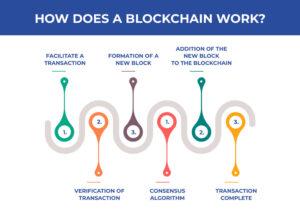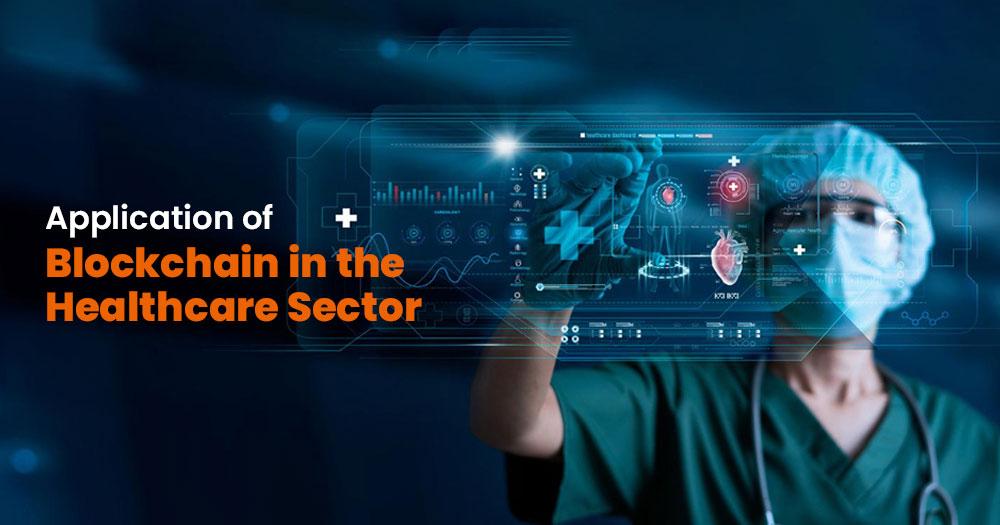What is Blockchain?
Blockchain is a system of distribution to record and maintains transaction data. Blockchain is a distributed, immutable record of peer-to-peer transactions made from connected transaction blocks and kept in a digital ledger.
It uses well-established cryptographic techniques to enable each network participant to communicate (e.g., store, exchange, and view information) without needing primary trust. The system has no central authority; the transaction records are maintained and dispersed among the network participants.
Interactions with the Blockchain are being seen by all parties and require network verification before they can add information. This enables trustless collaboration among network participants while keeping an immutable audit trail of all transactions.
How Does a Blockchain Work?

The working of Blockchain can be summarized as follows:
1. Facilitate a transaction: A new transaction enters the blockchain network. All the information that must be transmitted is double encrypted using public and private keys.
2. Verification of transaction: The transaction is then transferred to the network of peer-to-peer computers distributed worldwide. w will check all the nodes on the network for the transaction’s validity, like if a sufficient balance is available to carry out the transaction.
3. Formation of a new block: In a typical blockchain network, there are multiple nodes, and many transactions get verified at once. Once the transaction is verified and declared legitimate, it is added to the mem pool. All the verified transactions at a specific node form a mem pool, and various mem pools form a block.
4. Consensus Algorithm: The nodes that form a block will try for adding the block to the blockchain network to make the block permanent. But if each node is allowed to add blocks in this manner, it will disrupt the working of the blockchain network. To solve this problem, the nodes use a consensus mechanism to ensure that every new block added to the Blockchains is the only version of the truth that is agreed upon by all the nodes in the Blockchain. Only a valid block has securely been attached to the Blockchains. The node selected for adding a block to the Blockchain will get a reward; hence, we call them “miners.” The consensus algorithm creates a hash code for that block which is needed to add the block to the Blockchain.
5. Addition of the new block to the Blockchain: After the newly created block has the hash value and is authenticated, it is now ready to add to the Blockchain. In each block, there is a hash value of the previous block; that is how the blocks are cryptographically linked to every other to form a blockchain. A new block adds to the open end of the Blockchain.
6. Transaction complete: the time the block is added to the Blockchain, the transaction is completed, and the details of this transaction are permanently stored in the Blockchain. Anybody can fetch the details of the transaction and confirms the transaction.
You may also like to read: A Quick Guide To Blockchain Development And Its Technology
Application of blockchain in the Healthcare sector

- Provide Accommodation in Various Sectors
Blockchain can operate as a link among major healthcare industries such as hospitals, laboratories, and pharmacies, enabling data to be shared securely. Diagnostic records, previous treatments, current prescriptions, and insurance claims comprise most of the shared data.
2. Improved Patient treatment that is Faster, Less Expensive, and More Effective
Blockchain can build a single system to store and retrieve health records in a secure and timely manner by authorized users. c can avoid innumerable mistakes, faster diagnoses and interventions are possible, and care can be individualized to every patient to eliminate miscommunication between various healthcare personnel in caring for the same patient.
3. Genomic Data Protection
Genomic data theft has become a big problem as more companies deliver DNA sequencing to the individual. This can be avoided using Blockchain, and c can even use it to make an online marketplace where scientists can acquire genomic data for research reasons. This could be encouraged by secure selling while obviating the requirement for costly intermediaries.
4. Insurance and Supply Chain Settlements using Smart Contracts
Various companies offer blockchain-based systems that enable pharmaceutical companies, medical device OEMs, wholesalers, insurers, and healthcare providers. To authenticate their identities as organizations, log contract details, and track goods and services transactions as payment settlement details for those goods and services.
This environment goes beyond supply chain management to enable healthcare trading partners and insurance providers to operate on whole digital and, in some circumstances, automated contract terms.
Instead of every player having their version of contracts, they can reduce disputes over payment chargeback claims for prescription medicines and other goods by having shared digital contracts amongst manufacturers, distributors or healthcare organizations log on a blockchain ledger.
5. Medical Data Security Assurance
Pharmaceutical corporations invest millions of dollars in drug research and development, but keeping their trade secrets hidden is possibly even more vital. If such stores of valuable data were to be leaked to competitors, pharma companies might lose considerable market share relatively quickly.
Medical data is traditionally stored in an unreadable manner across remote servers and then dispersed into tiny bits via encryption, ensuring that no party may unilaterally decrypt, change or transfer that information across multiple channels.
6. Improving Communication Between Providers and Patients
The usage of blockchain technology may be an excellent solution to this problem. Decentralized blockchain solutions are available. As a result, the data is spread over various network nodes instead of being stored in a single database.
When information in one node is transformed or updated, it is updated in whole network nodes. It simplifies the methodology of immediately sharing updated information with any doctor or healthcare practitioner.
The information kept on a blockchain is legitimate, up-to-date, and timestamped, making it easy for providers to review and act on it, especially in an emergency. It aids clinicians in making more individualized treatment programs and completing diagnoses more rapidly.
While there are great applications of Blockchains technology in the healthcare sector, it has yet to develop that can be used instantly fully. Before companies can embrace a healthcare blockchain in the country, they must overcome several technical, organizational, and behavioural economic difficulties.
You may also like to read: Importance of Big Data in Healthcare
How Blockchain can optimize healthcare
Can transform blockchain technology in healthcare. It can assist achieve:
- Security
- Privacy
- The integration of health data
Capitalizing on this technology can connect fragmented systems to generate insights and assess care value more efficiently. In the long term, a nationwide blockchain network for electronic medical records may improve efficiencies and support better patient health results.
It offers the chance for a new technological model in an HIE that creates electronic medical records more effectively and securely. It can also minimize or eliminate the friction and costs of current intermediaries.
Future of Blockchain in Healthcare
Blockchain technology aids in the resolution of some of the healthcare industry’s most pressing problems. As a result, its breadth will only maximize.
With the rise of technological tools for facilitating the sharing of patient information and improving healthcare procedures, the industry is seeking secure and transparent ways for conducting operations so that the systems are entirely authentic and their patients are sure of it.
The use case of blockchain Protocol in the industry has already started due to its decentralized structure and ability to make resilient and secure solutions. As time goes on, the number of applications will maximize. It’s also possible that we will use it in conjunction with other technologies like Machine Learning and AI for improving medical care and healthcare blockchain solutions.
Conclusion
The use of blockchain technology in healthcare has the potential to transform the industry, improving data security, interoperability, patient empowerment, and outcomes. While there are challenges to be overcome, such as regulatory compliance and interoperability, the benefits of blockchain in healthcare are clear. As this technology continues to mature, we can expect to see even greater innovation and impact in the years ahead.



This blog is really informative, especially anyone who has no information about Blockchain.
The blog is very well structured and has content articulated in words which can be read well even by the audience who are unaware about this sphere. This, with the other blogs about AI and data science present on the blog seem to leave readers hooked with no doubts and it feels great to consume such a piece of information amidst the abundant data available on the internet.
The data, analysis, and content, put in the blog is exceptionally well curated, which in all makes the blog complete. The application, uses, along with different uses of Blockchain in different spheres leaves no ambiguity for the reader, I feel that this piece of content is enough to make the readers aware about the basics and every piece of info required to start learning from scratch.
It’s a very interesting and informative blog .
All hands on to it, Great work and hope this will be helpful to a lot of students and aspiring data scientists….
Informative! Really shocked me …
Very Interesting blog and must read for even those who want to learn from start.
Very Informative blog , provides a lot of valuable information about the blockchain.